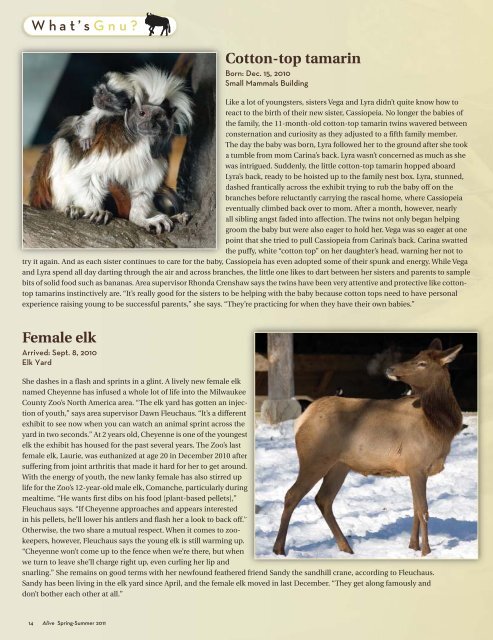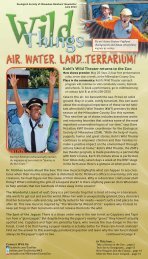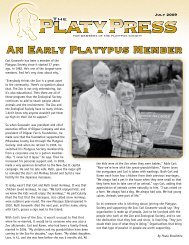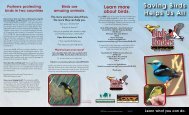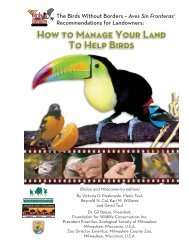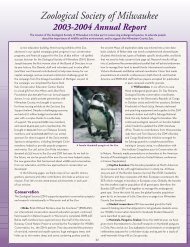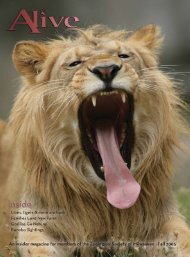Bonobo - Zoological Society of Milwaukee
Bonobo - Zoological Society of Milwaukee
Bonobo - Zoological Society of Milwaukee
You also want an ePaper? Increase the reach of your titles
YUMPU automatically turns print PDFs into web optimized ePapers that Google loves.
What’sGnu?<br />
14 Alive Spring-Summer 2011<br />
Cotton-top tamarin<br />
Born: Dec. 15, 2010<br />
Small Mammals Building<br />
Like a lot <strong>of</strong> youngsters, sisters Vega and Lyra didn’t quite know how to<br />
react to the birth <strong>of</strong> their new sister, Cassiopeia. No longer the babies <strong>of</strong><br />
the family, the 11-month-old cotton-top tamarin twins wavered between<br />
consternation and curiosity as they adjusted to a fifth family member.<br />
The day the baby was born, Lyra followed her to the ground after she took<br />
a tumble from mom Carina’s back. Lyra wasn’t concerned as much as she<br />
was intrigued. Suddenly, the little cotton-top tamarin hopped aboard<br />
Lyra’s back, ready to be hoisted up to the family nest box. Lyra, stunned,<br />
dashed frantically across the exhibit trying to rub the baby <strong>of</strong>f on the<br />
branches before reluctantly carrying the rascal home, where Cassiopeia<br />
eventually climbed back over to mom. After a month, however, nearly<br />
all sibling angst faded into affection. The twins not only began helping<br />
groom the baby but were also eager to hold her. Vega was so eager at one<br />
point that she tried to pull Cassiopeia from Carina’s back. Carina swatted<br />
the puffy, white “cotton top” on her daughter’s head, warning her not to<br />
try it again. And as each sister continues to care for the baby, Cassiopeia has even adopted some <strong>of</strong> their spunk and energy. While Vega<br />
and Lyra spend all day darting through the air and across branches, the little one likes to dart between her sisters and parents to sample<br />
bits <strong>of</strong> solid food such as bananas. Area supervisor Rhonda Crenshaw says the twins have been very attentive and protective like cottontop<br />
tamarins instinctively are. “It’s really good for the sisters to be helping with the baby because cotton tops need to have personal<br />
experience raising young to be successful parents,” she says. “They’re practicing for when they have their own babies.”<br />
Female elk<br />
Arrived: Sept. 8, 2010<br />
Elk Yard<br />
She dashes in a flash and sprints in a glint. A lively new female elk<br />
named Cheyenne has infused a whole lot <strong>of</strong> life into the <strong>Milwaukee</strong><br />
County Zoo’s North America area. “The elk yard has gotten an injection<br />
<strong>of</strong> youth,” says area supervisor Dawn Fleuchaus. “It’s a different<br />
exhibit to see now when you can watch an animal sprint across the<br />
yard in two seconds.” At 2 years old, Cheyenne is one <strong>of</strong> the youngest<br />
elk the exhibit has housed for the past several years. The Zoo’s last<br />
female elk, Laurie, was euthanized at age 20 in December 2010 after<br />
suffering from joint arthritis that made it hard for her to get around.<br />
With the energy <strong>of</strong> youth, the new lanky female has also stirred up<br />
life for the Zoo’s 12-year-old male elk, Comanche, particularly during<br />
mealtime. “He wants first dibs on his food [plant-based pellets],”<br />
Fleuchaus says. “If Cheyenne approaches and appears interested<br />
in his pellets, he’ll lower his antlers and flash her a look to back <strong>of</strong>f.”<br />
Otherwise, the two share a mutual respect. When it comes to zookeepers,<br />
however, Fleuchaus says the young elk is still warming up.<br />
“Cheyenne won’t come up to the fence when we’re there, but when<br />
we turn to leave she’ll charge right up, even curling her lip and<br />
snarling.” She remains on good terms with her newfound feathered friend Sandy the sandhill crane, according to Fleuchaus.<br />
Sandy has been living in the elk yard since April, and the female elk moved in last December. “They get along famously and<br />
don’t bother each other at all.”


